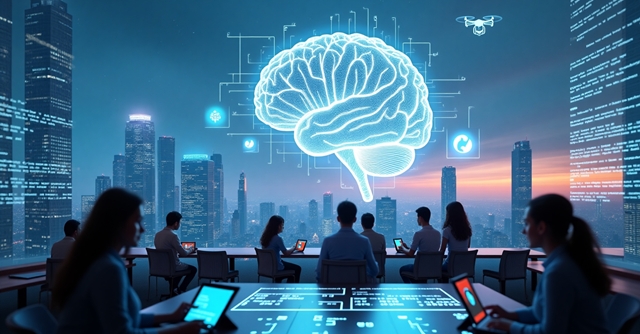
New Delhi, April 11 -- The recent success of DeepSeek, a Chinese artificial intelligence (AI) company, which built a powerful AI model with what it claimed was a fraction of the typical computing resources, has underscored the potential of open-source AI to drive efficiency and innovation in unexpected ways.
Open-source models provide a platform for developers, researchers and even hobbyists to experiment and innovate. For example, when Meta released its Llama models, developers worldwide created novel applications and improvements that far exceeded initial expectations. Experts believe open-source AI is poised to be the future because it democratises access to advanced technology, leading to faster progress and more robust solutions.
Building trust through transparency
It is known that AI's "black box" problem undermines trust and limits adoption, particularly in sensitive or regulated industries. Open-source models address this by making their workings visible and verifiable.
These concerns are not present in open-source AI models as they allow companies to use AI capabilities without risking internal information leakage. Additionally, they make it easier and perhaps even more feasible for companies to comply with international regulations and Personally Identifiable Information (PII) laws.
"While commercial AI often requires subscriptions, open-source Large Language Models (LLMs) generally have no local usage fees, incurring costs only on cloud infrastructure or through Application Programming Interface (API) access," believes Abhinav Puri, General Manager of Portfolio Solutions & Services at open-source software and services firm SUSE.
At its recent flagship event in Orlando in March, SUSE CEO Van Leeuwen said that "open-source will only get bigger and richer," as it lowers costs, streamlines business processes, speeds up product development, and improves infrastructure management. Moreover, Open-source AI's benefits extend beyond cost savings. Its open nature fosters community-driven development, improving quality, bug removal, and bias mitigation through public scrutiny, particularly crucial for diverse data training.
Marshal Correia, Vice President and General Manager for India and South Asia, Red Hat, also noted that "more customers are leveraging open source for transformative change, showcasing agility and resilience while addressing unique challenges like infrastructure modernisation and cost efficiency."
Open-source AI further enhances corporate IT security by preventing data leakage, allowing businesses to tailor AI with internal data through secure sandboxes and retraining. Although running LLMs requires significant hardware, especially GPUs, interest is growing in less resource-intensive small language models (SLMs).
Avirag Jain, CTO and Executive VP at digital product engineering firm R Systems noted, "With generative AI becoming more prevalent in enterprises, companies will likely leverage smaller models, fine-tuning them with proprietary data to achieve desired performance at a fraction of the cost." In such cases, open-source access fosters diverse perspectives and removes barriers to innovation.
The recent DeepSeek model also exemplifies a hybrid approach for that matter. Although it is classified as an LLM due to its capabilities, it prioritises efficiency and can operate on lower-powered hardware. DeepSeek employs distillation techniques to create smaller, more accessible versions of its models, making them suitable for resource-constrained environments.
Balakrishna D. R., Executive VP at Infosys believes that AI leaders have a responsibility to balance innovation with ethics. Open-source AI promotes accountability through audits and transparency, ensuring AI serves humanity responsibly and equitably. Companies embracing open-source amplify their competitive edge through collective intelligence, even through small contributions of tools and datasets.
This approach exemplifies how collaboration and inclusivity can drive innovation while fostering a shared vision for a more connected and equitable tech future, and technology and software business leaders need to understand the amazing potential of working in an open environment.
Is open source 'truly' open?
Some critics however claim that several AI models claim to be open but are not fully open-source in the traditional OSI sense. This is popularly referred to as open-source washing or open washing. The lack of transparency, especially about the training data has led to several lawsuits against big AI companies.
"Most companies claiming to be open-source merely provide open weights, not full transparency. Open-washing is deceptive - allowing only fine-tuning while restricting system-level changes prevents true openness. Real open-source AI is pro-competition and pro-innovation," Avijit Ghosh, Applied Policy Researcher (ML & Society) at AI development platform Hugging Face told TechCircle in an interview.
Notably, in January, Hugging Face initiated Open-R1 project, an initiative to build open version of the DeepSeek-R1 model by reconstructing its data and training pipeline.
Experts like Kashyap Kompella, who is the chief executive officer of RPA2AI Research, believe that companies have the right to choose licensing models that align with their business interests. However, they face criticism when engaging in presenting their models as open-source while keeping key components proprietary.
Proponents like SUSE's Van Leeuwen however noted that "the future of AI is open, collaborative and transparent" and "despite having a long way to go, open-source offers the 'power of choice' to customers and companies that embrace openness and efficiency will set the pace for the next wave of AI innovation.
Published by HT Digital Content Services with permission from TechCircle.
